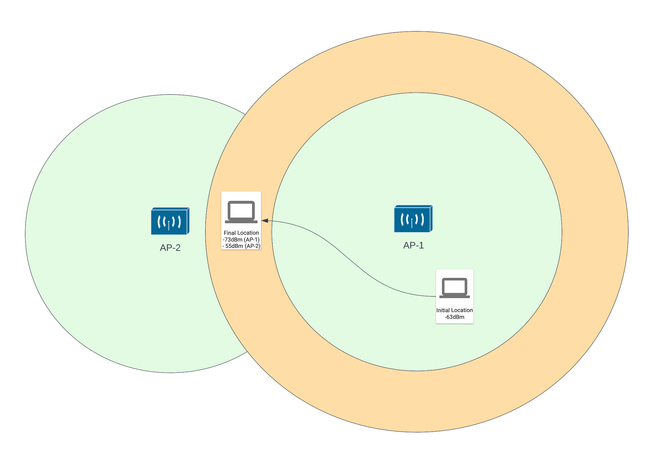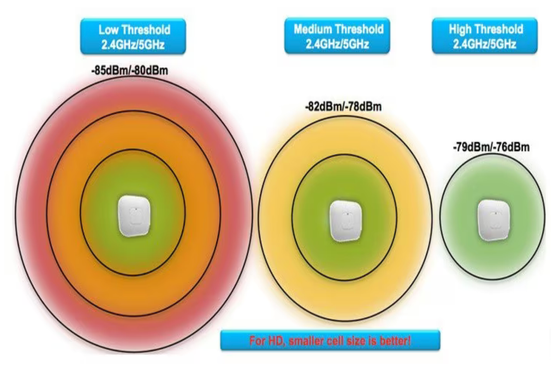Get answers from our community of experts in record time.
Join now- Technical Forums
- :
- Wireless
- :
- RX-SOP - SNR and RSSI
RX-SOP - SNR and RSSI
Solved- Subscribe to RSS Feed
- Mark Topic as New
- Mark Topic as Read
- Float this Topic for Current User
- Bookmark
- Subscribe
- Mute
- Printer Friendly Page
- Mark as New
- Bookmark
- Subscribe
- Mute
- Subscribe to RSS Feed
- Permalink
- Report Inappropriate Content
RX-SOP - SNR and RSSI
Hello all,
I would like to explore the RX-SOP option
https://documentation.meraki.com/MR/Radio_Settings/Receive_Start_of_Packet_(RX-SOP)
mainly because of the MACOS stickiness issue.
MACOS devices tend not to roam to another access point even if the RSSI is -75dBm.
https://support.apple.com/en-us/HT206207
The Meraki portal (under client) shows values in SNR even if this is called signal!
https://documentation.meraki.com/MR/Wi-Fi_Basics_and_Best_Practices/Signal-to-Noise_Ratio_(SNR)_and_...
I am aware that SNR = RSSI - Noise. But how can I find the noise level on the Meraki Portal for a specific AP, so I can calculate the RSSI. We use MR33/42/53.
Is there another way to find the RSSI, so I can set the RX-SOP limits? I am also aware that I can find the noise on my Laptop, but I assume that value is different on the AP, and also Meraki suggests that WLAN cards are not designed to measure noise floors.
The typical WLAN card on a laptop is not designed to measure the noise floor of its surrounding and special adapters like the Wi-Spy dBx are needed
Solved! Go to solution.
- Labels:
-
Interference
-
RF Spectrum
- Mark as New
- Bookmark
- Subscribe
- Mute
- Subscribe to RSS Feed
- Permalink
- Report Inappropriate Content
802.11k should always be on @PhilipDAth, that feature is related to roaming but is quite different than 802.11r.
For Apple devices you have two requirements to roam. The RSSI at the client from the currently connected AP must be below -75 and the signal of the candidate AP needs to be at least 10 dB higher. So if your network is not designed with enough overlap/secondary AP signal then you'll have sticky clients.
RX-SOP is only to be used in environments with lot's of AP's from own installation and neighbor installation that interfere with each other. It does NOT help in any way for your roaming.
To calculate your RSSI from your SNR you could take -92 dBm as noise floor on 2.4 GHz and -95 dBm on 5 GHz and add our SNR to that to get the RSSI.
- Mark as New
- Bookmark
- Subscribe
- Mute
- Subscribe to RSS Feed
- Permalink
- Report Inappropriate Content
Just remember that roaming is a client decision. By the way, how is the minumum bit rate configured?
Please, if this post was useful, leave your kudos and mark it as solved.
- Mark as New
- Bookmark
- Subscribe
- Mute
- Subscribe to RSS Feed
- Permalink
- Report Inappropriate Content
Thank you. Unfortunately with MACOS there is no way (unless I am missing something important) to change that behavior, while with Windows OS there are settings like roaming aggressiveness etc.
So I am trying to solve this through Optimized Roaming on the AP level.
https://www.cisco.com/c/en/us/td/docs/wireless/controller/technotes/8-0/hdx_final/b_hdx_dg_final/hig...
Bit Rate: 18Mbps at the moment, I can increase it to 24Mbps or 36Mbps.
- Mark as New
- Bookmark
- Subscribe
- Mute
- Subscribe to RSS Feed
- Permalink
- Report Inappropriate Content
I don't believe changing RX-SOP will help you here - it affects how APs treat received frames, whereas it appears that Macs look only at the RSSI as they see it, when making choices about which AP to use. In general I'd be very careful messing about with RX-SOP - I would certainly think about talking to Meraki Support via a case, beforehand.
- Mark as New
- Bookmark
- Subscribe
- Mute
- Subscribe to RSS Feed
- Permalink
- Report Inappropriate Content
Thank you. I will definitely raise a case with Meraki.
Changing the RX-SOP is my last option and I am not sure if this has the results I believe, but at the moment there are so many problems: lack of a proper wireless site survey, MAC stickiness, DFS, high density, high interference from other offices is, so I need to try a few things because the end user experience is really bad.
- Mark as New
- Bookmark
- Subscribe
- Mute
- Subscribe to RSS Feed
- Permalink
- Report Inappropriate Content
If you aren't using 802.11r, try setting it to adaptive (or enabled). This also enables 802.11k.
Mac OS does use 802.11r for roaming assistance.
- Mark as New
- Bookmark
- Subscribe
- Mute
- Subscribe to RSS Feed
- Permalink
- Report Inappropriate Content
Thank you. We are using Adaptive. I have also tested with Enabled. Unfortunately, there is no difference. Actually, my MACOS device supports 802.11r.
In general, the MACOS devices won't move to a better AP, unless I disassociate them from the SSID. Turn Wireless OFF/ON still doesn't fix the problem
sudo /System/Library/PrivateFrameworks/Apple80211.framework/Versions/Current/Resources/airport --disassociate
Based on my understanding the APs cannot enforce roaming.
The clients driver uses the received signal strength of beacons or probe responses to make decisions on whether to change APs or remain connected to the current AP.
https://documentation.meraki.com/MR/Wi-Fi_Basics_and_Best_Practices/Client_roaming_and_connectivity_...
- Mark as New
- Bookmark
- Subscribe
- Mute
- Subscribe to RSS Feed
- Permalink
- Report Inappropriate Content
Check it out: https://support.apple.com/en-is/HT202068
Please, if this post was useful, leave your kudos and mark it as solved.
- Mark as New
- Bookmark
- Subscribe
- Mute
- Subscribe to RSS Feed
- Permalink
- Report Inappropriate Content
802.11k should always be on @PhilipDAth, that feature is related to roaming but is quite different than 802.11r.
For Apple devices you have two requirements to roam. The RSSI at the client from the currently connected AP must be below -75 and the signal of the candidate AP needs to be at least 10 dB higher. So if your network is not designed with enough overlap/secondary AP signal then you'll have sticky clients.
RX-SOP is only to be used in environments with lot's of AP's from own installation and neighbor installation that interfere with each other. It does NOT help in any way for your roaming.
To calculate your RSSI from your SNR you could take -92 dBm as noise floor on 2.4 GHz and -95 dBm on 5 GHz and add our SNR to that to get the RSSI.
- Mark as New
- Bookmark
- Subscribe
- Mute
- Subscribe to RSS Feed
- Permalink
- Report Inappropriate Content
Thank you. The problem with MACOS is that, based on my understanding, no matter the overlapping, the client can "get stuck" within an area of let's say -72dB to -73dBm. I experienced this case below, where I was not able to roam, unless I disassociate / associate. Turn Wireless OFF / ON doesn't fix the problem.
https://support.apple.com/en-us/HT206207
Consider this threshold in view of the signal overlap between your wireless cells. macOS maintains a connection until the -75 dBm threshold, but 5 GHz cells are designed with a -67 dBm overlap.
I was hoping to fix this with RX-SOP - Cisco Marketing advertisement worked for me 😁, but thank you for the update. Based on your feedback and the more I read about this feature the more I am convinced that this is not the way to move forward, but it could help with other things you mentioned, like other AP interference.
- Mark as New
- Bookmark
- Subscribe
- Mute
- Subscribe to RSS Feed
- Permalink
- Report Inappropriate Content
If you configure RX-SOP your clients won't know about it. You basically just tell the AP to not listen to frames below a certain RSSI threshold and transmit over them at those levels if you have stuff to send.
It won't help one bit with roaming,
The only way to have good roaming is having the correct coverage (which means enough secondary AP signal) so the client can easily see both AP's and the AP's see each other a bit which helps with info contained in 802.11k and 802.11v which in turn will help clients find the next AP faster and have a better time roaming.




